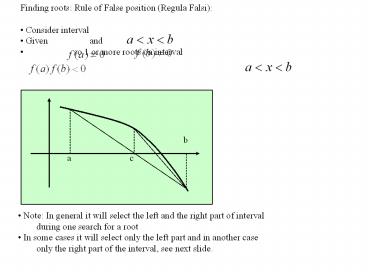Finding roots: Rule of False position (Regula Falsi): - PowerPoint PPT Presentation
1 / 12
Title:
Finding roots: Rule of False position (Regula Falsi):
Description:
Finding roots: Rule of False position (Regula Falsi): Consider interval. Given and. so 1 or more roots on interval ... Note: In general it will select the left ... – PowerPoint PPT presentation
Number of Views:712
Avg rating:3.0/5.0
Title: Finding roots: Rule of False position (Regula Falsi):
1
- Finding roots Rule of False position (Regula
Falsi) - Consider interval
- Given and
- so 1 or more roots on
interval
b
a
c
- Note In general it will select the left and the
right part of interval - during one search for a root
- In some cases it will select only the left part
and in another case - only the right part of the interval, see next
slide.
2
In interval point of inflection
b
1
a
2
Consider this when preparing the function
RegulaFalsi!
3
Algorithm
Rule of False position converges always,
sometimes slow.
4
- Finding roots Newton Raphson
- Select a point on the graph of f(x)
- Draw the tangent in that point
- Determine intersection of the tangent with
x-axis - Repeat procedure in the intersection until root
is accurate
5
p1
p2
p0
Recursive formula
Problem?
6
Newton Raphson does not converge always, for
example
Start x0 gives
7
Fixed point iteration
Suppose you want a root of
So
Or
and
(equivalent form)
Fixed point iteration works as follows
x0 4 x1 3.31662 x2 3.10375 x3 3.01144 .
. . xn 3.0
Start value is
Compute successively
etc. Hopefully it will converge.
Stop when
8
In general, one may derive other equivalent
forms, e.g.
9
- Iterations
- Sometimes do not converge
- An iteration may be written as
- F does not need to be a mathematical function!
- Convergence requires for all
- This should hold for
- So if iteration does not converge try another
- start point.
10
- Advantages of iterations seen from Computer
Science perspective - Iterations are simple to program
- If iteration converges then arithmetic errors
will be resolved - in the next iteration
- Suppose you need to know the roots of
- Which method is better?
- quadratic-formula
- iterative method like Rule of False position
11
Stop conditions For example Newton iteration to
compute
e 0.01
- Criteria
- absolute
- relative
- combined
If a 1 then tolerance 1. If a 10 then
tolerance 0.1 For large values strict
Strict for small values, better suited for large
values
For small values of a ad is small absolute
criterion For large values of a e
negligible relative criterion
12
- Divide and conquer
- Suppose one needs to prepare a function to find
the first 100 - prime numbers
- Prepare two functions
- one function that tests whether a number is
prime - another function that finds the first 100 prime
numbers - In this second function you call the first
function. - Separation of responsibilities and
- the function is clear and can be maintained more
easily































